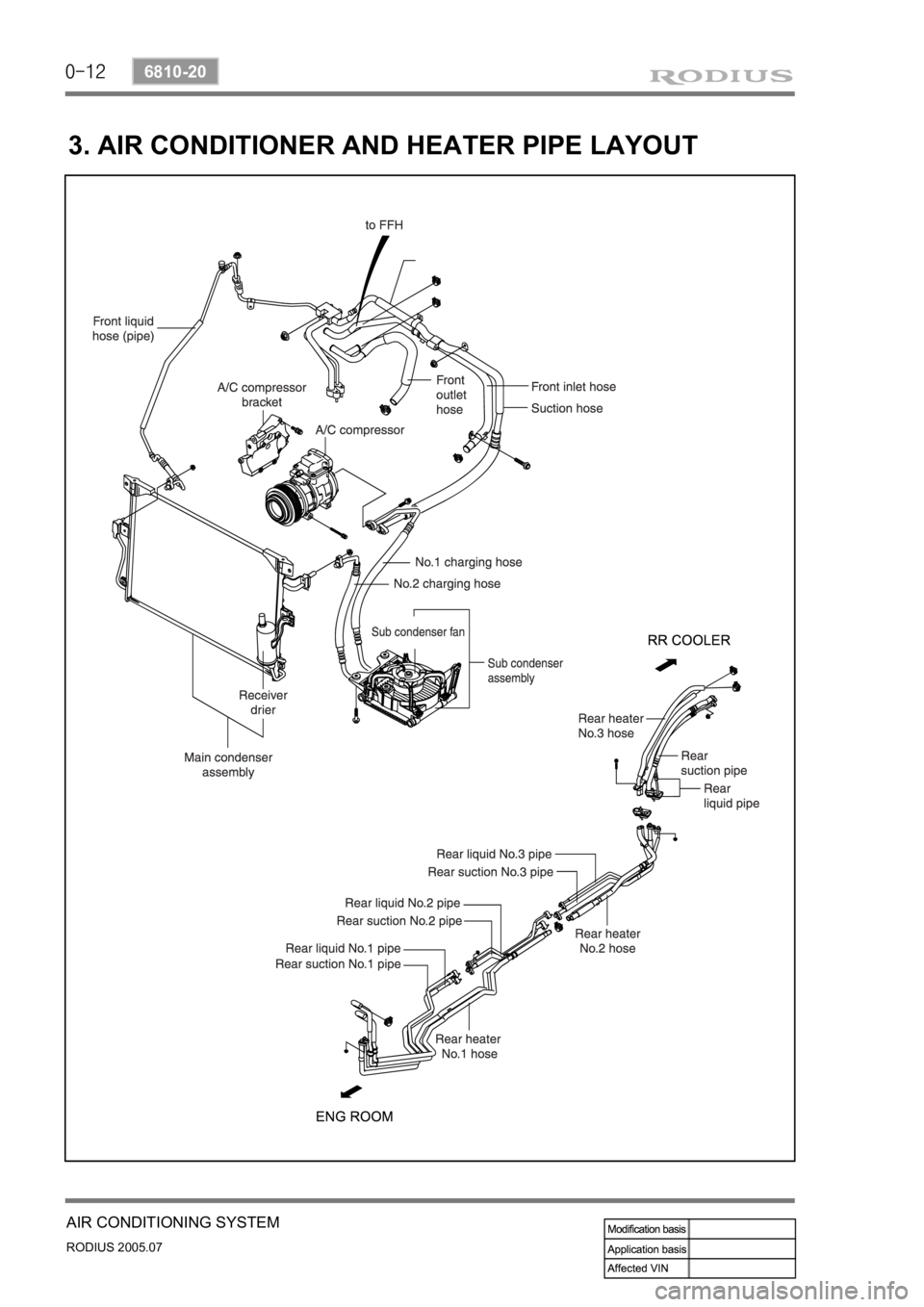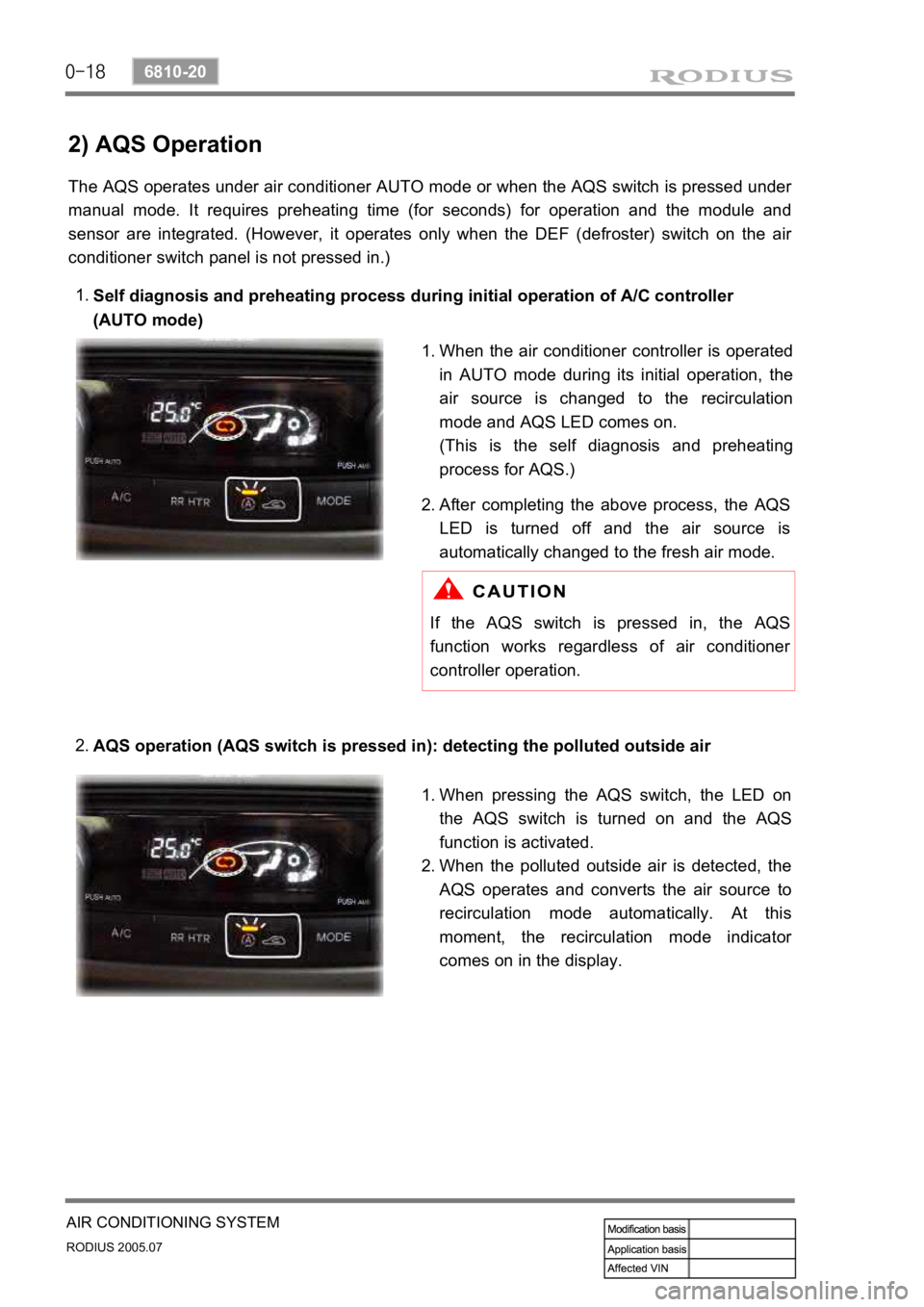SSANGYONG RODIUS 2005 Service Manual
Manufacturer: SSANGYONG, Model Year: 2005, Model line: RODIUS, Model: SSANGYONG RODIUS 2005Pages: 502, PDF Size: 70.43 MB
Page 421 of 502

0-12
RODIUS 2005.07
6810-20
AIR CONDITIONING SYSTEM
3. AIR CONDITIONER AND HEATER PIPE LAYOUT
Page 422 of 502

0-13
AIR CONDITIONING SYSTEM
RODIUS 2005.07
6810-20
4. SENSORS AND ACTUATORS
1) Sun Sensor
It is installed on the upper left end of instrument panel. It is using characteristics that the
amount of current changes according to amount of light on the photosensitive surface. Photo
diode, converts the changes in light intensity into electrical changes, detects the amount of light
coming through windshield and changes it into current and then sends the signal to FATC
controller.
(1) Inspection
Remove the sun sensor and measure the current between terminals under sunlight.
Measure the current again under shade. It is in normal conditions if the measured value is
less than the measured value under sunlight.
Turn the ignition switch to “ON” position.
Measure the voltage to the sun sensor from FATC connector. (approx. 2.5 V under sunlight
and 4.8 V under shade.)
If the voltage value cannot be measured, check the circuit for open. If the measured value is
within the specified range, replace the FATC controller. 1.
2.
3.
4.
5.
Page 423 of 502

0-14
RODIUS 2005.07
6810-20
AIR CONDITIONING SYSTEM
2) Active Incar/Humidity Sensor (AIH Sensor)
The AIH sensor is installed at the driver side instrument panel undercover. It is a sensor that
detects interior temperature and humidity.
(1) Location
(2) Functions
Interior temperature sensor
▶
This sensor is a negative temperature coefficient (NTC) thermistor and detects the interio
r
temperature with air coming from senor hole and then sends the voltage value according to the
changed resistance to FATC controller.
Humidity sensor
▶
This sensor detects the interior humidity with humidity cell and then sends the voltage value
according to the changed humidity to FATC controller.
Humidity
sensor
Active incar sensor
(interior temperature
sensor)
Page 424 of 502

0-15
AIR CONDITIONING SYSTEM
RODIUS 2005.07
6810-20
(3) Inspection
If the active incar sensor defect code (DTC 1) and the humidity sensor defect code (DTC 10)
are set, check as below:
Air conditioner controller
Air conditioner controller connector (based on wiring) AIH sensor (based on sensor)
Active incar sensor
▶
Remove the integrated AIH sensor and measure the resistance between terminal No. 5 and
6 on the sensor connector. (standard: approx. 25°C, 2.2 kΩ)
If the measured value is out of the specified range, replace the AIH sensor. If the measured
values are within the specified range, check as below.
Turn the ignition switch to ON position and measure the voltage to active incar sensor from
the FATC controller connector. (standard: approx. 2 V at 25°C)
If the voltage value cannot be measured, check the circuit for open. If the measured value is
within the specified range, replace the FATC controller.
1.
2.
3.
4.
Page 425 of 502

0-16
RODIUS 2005.07
6810-20
AIR CONDITIONING SYSTEM
Humidity sensor ▶
Apply 5 V to terminal No. 1 and 3 on the humidity sensor connector.
Connect the positive (+) probe of a tester on No. 2 terminal and the negative (-) probe on
No. 3 terminal, and measure the output voltage while the voltage is applied.
(output voltage: approx. 0.8 ~ 3.4 V)
Check whether the output voltage is changed when blowing into the inlet of the sensor. I
f
there is a voltage change, the sensor is in normal condition. However, if the voltage is not
changed, replace the humidity sensor.
In addition, if the output voltage is extremely high or low even in the specified range, replace
the humidity sensor. 1.
2.
3.
4.
Page 426 of 502

0-17
AIR CONDITIONING SYSTEM
RODIUS 2005.07
6810-20
5. AIR QUALITY SYSTEM (AQS)
1) Components of AQS
Air Quality System (AQS) changes the air source selection to recirculation mode when polluted
air is detected through AQS sensor. The air source selection returns back to fresh air intake
mode after a specified period or the polluted air is disappeared.
AQS sensor and ambient temperature sensor
AQS sensor
Ambient
temperature
sensor
Connector
AQS and air source selection switch
The AQS switch is integrated with the air source selection switch.
AUTO Mode
The air source is not changed when pressing the AQS and air
source selection switch in “AUTO” mode. However, the
indicator on the switch turned ON/OFF. In other words, the air
source cannot be changed to recirculation mode in AUTO mode
by just pressing the switch. To change the air source to
recirculation mode in AUTO mode, get into Manual mode first,
then press the air source selection switch.
Manual Mode
To change the AQS mode to Manual mode from AUTO mode,
use the MODE switch or the fan speed control dial. In Manual
mode, the “AUTO” symbol on the display is disappeared.
When pressing the AQS and air source selection switch, the
mode is changed in order of AQS LED ON, AQS LED OFF
(fresh air), and air source LED ON (recirculation).
The figure shows that the mode has been changed to the
recirculation mode from fresh air mode under AQS mode (AQS
LED ON) after detecting the polluted outside air.
Page 427 of 502

0-18
RODIUS 2005.07
6810-20
AIR CONDITIONING SYSTEM
2) AQS Operation
The AQS operates under air conditioner AUTO mode or when the AQS switch is pressed under
manual mode. It requires preheating time (for seconds) for operation and the module and
sensor are integrated. (However, it operates only when the DEF (defroster) switch on the ai
r
conditioner switch panel is not pressed in.)
Self diagnosis and preheating process during initial operation of A/C controller
(AUTO mode)
1.
AQS operation (AQS switch is pressed in): detecting the polluted outside air
2.
When the air conditioner controller is operated
in AUTO mode during its initial operation, the
air source is changed to the recirculation
mode and AQS LED comes on.
(This is the self diagnosis and preheating
process for AQS.)
1.
After completing the above process, the
AQS
LED is turned off and the air source is
automatically changed to the fresh air mode.
2.
If the AQS switch is pressed in, the AQS
function works regardless of air conditioner
controller operation.
When pressing the AQS switch, the LED on
the AQS switch is turned on and the
AQS
function is activated.
When the polluted outside air is detected, the
AQS operates and converts the air source to
recirculation mode automatically. At this
moment, the recirculation mode indicato
r
comes on in the display.
1.
2.
Page 428 of 502

0-19
AIR CONDITIONING SYSTEM
RODIUS 2005.07
6810-20
When driving out of polluted area 3.
If the polluted air is disappeared, the air
source is automatically changed to the fresh
air mode and AQS LED stays on.
The air source is not changed when pressing
the AQS and air source selection switch in
“AUTO” mode. To change the air source to
recirculation mode in AUTO mode, get into
Manual mode first, then press the air source
selection switch. 1.
2.
Page 429 of 502
![SSANGYONG RODIUS 2005 Service Manual 0-20
RODIUS 2005.07
6810-20
AIR CONDITIONING SYSTEM
3) AQS Operation Circuit
1. Ambient temperature switch
2. Sensor ground
3. AQS signal (Output)
4. Ground
5. IGN 2
[AQS sensor] ▶
Measure the volt SSANGYONG RODIUS 2005 Service Manual 0-20
RODIUS 2005.07
6810-20
AIR CONDITIONING SYSTEM
3) AQS Operation Circuit
1. Ambient temperature switch
2. Sensor ground
3. AQS signal (Output)
4. Ground
5. IGN 2
[AQS sensor] ▶
Measure the volt](/img/67/57522/w960_57522-428.png)
0-20
RODIUS 2005.07
6810-20
AIR CONDITIONING SYSTEM
3) AQS Operation Circuit
1. Ambient temperature switch
2. Sensor ground
3. AQS signal (Output)
4. Ground
5. IGN 2
[AQS sensor] ▶
Measure the voltage value of AQS. (between connector terminal No. 3 and 4.)
If the measured voltage is out of 0.1 to 4.8 V, replace the AQS.
If the measured voltage is out of the specified range, replace the AQS. If it is within the
specified range, check as below.
Turn the ignition key to “ON” position.
Measure the voltage between terminal B9 and B15 on the air conditioner controller.
If the voltage value cannot be measured, check the circuit for open. If the measured value is
within the specified range, replace the FATC controller. 1.
2.
3.
4.
5.
6.
Remove the sensor and measure the resistance between terminal No. 5 and 6 on the senso
r
connector. (standard: approx. 25°C, 2.2 kΩ) In addition, if the resistance is extremely
high or low, replace the sensor.
If the measured value is out of the specified range, replace the ambient temperature sensor.
If the measured value is within the specified range, check as below.
Turn the ignition switch to ON position and measure the voltage to ambient temperature
sensor from the FATC controller connector. (standard: approx. 2 V at 25°C)
If the voltage value cannot be measured, check the circuit for open. If the measured value is
within the specified range, replace the FATC controller. 1.
2.
3.
4.[Ambient temperature sensor] ▶
Page 430 of 502

0-21
AIR CONDITIONING SYSTEM
RODIUS 2005.07
6810-20
6. AIR CONDITIONER MODULE SENSORS AND ACTUATORS
1) Duct Temperature Sensor
The duct temperature sensor is installed on the top of heater unit. It detects the inside
temperature of duct and transmits the voltage value that is changed according to resistance
value (NTC) to FATC controller.
(1) Inspection
If the duct temperature sensor defect code (DTC 3) is set, check as below.
▶
Remove the duct temperature sensor and measure the resistance between terminals on the
sensor connector. (standard: approx. 25°C, 2.2 kΩ) In addition, if the resistance is
extremely high or, replace the sensor.
If the measured value is out of the specified range, replace the duct temperature sensor. I
f
the measured value is within the specified range, check as below.
Turn the ignition switch to ON position and measure the voltage to duct temperature senso
r
from the FATC controller connector.
(standard: approx. 2 V at 25°C)
If the voltage value cannot be measured, check the circuit for open. If the measured value is
within the specified range, replace the FATC controller.
1.
2.
3.
4.